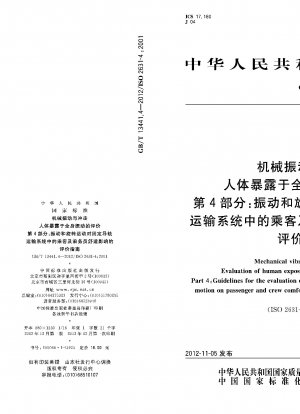GB/T 13441.4-2012
Mechanical vibration and shock.Evaluation of human exposure to whole-body vibration.Part 4:Guidelines for the evaluation of the effects of vibration and rotational motion on passenger and crew comfort in fixed-guideway transport systems (English Version)
- Standard No.
- GB/T 13441.4-2012
- Language
- Chinese, Available in English version
- Release Date
- 2012
- Published By
- General Administration of Quality Supervision, Inspection and Quarantine of the People‘s Republic of China
- Latest
- GB/T 13441.4-2012
- Scope
- This part of GB/T 13441 is the specific application of GB/T 13441.1, that is, the evaluation guide for the impact of mechanical vibration on the comfort of passengers and crew members in fixed rail transportation systems. It is intended to be used by organizations purchasing, ordering technical specifications, or applying fixed rail systems to help these organizations understand the design of fixed rail transportation systems and the relationship between other characteristics of the system and the comfort of passengers and crew. This guideline establishes an evaluation method for relative comfort between systems, rather than absolute comfort levels. This section applies to normal healthy persons exposed to linear vibrations along the x, y and z axes, and rotational vibrations about the three axes around the center of the body. The aim is to provide guidance for comfort assessment using a motion function generated by human motion along and around the vehicle's coordinate axes. This section applies neither to high-amplitude single transient movements that may cause injury, such as vehicle accidents or impacts from longitudinal listing impulses, nor to high-amplitude vibrations that may affect health. This section applies to fixed rail passenger transport systems including Rail systems (heavy rail and light rail), magnetically levitated rail (MAGLEV) systems and rubber-tyred subway systems, as well as the aforementioned various transportation systems that rely on roll behavior to counteract lateral acceleration when navigating curves. This section provides guidance on the possible effects of motion sickness caused by ultra-low frequency accelerations (0.1 Hz to 0.5 Hz) produced by vertical forces. These vertical forces may be the result of a combination of curve easing, superelevation, and body dumping techniques. However, this section does not provide guidance on comfort effects of ultra-low frequency accelerations (below 0.5 Hz) produced by lateral forces or longitudinal forces. Such ultra-low frequency accelerations are produced by the geometry of the rails (horizontal alignment and slope). This section only gives guidance on the evaluation of ride comfort based on the sports environment.
GB/T 13441.4-2012 Referenced Document
- GB/T 13441.1-2007 Mechanical vibration and shock Evaluation of human exposure to whole-body vibration Part 1: General requirements
- IEC 61260 Amendment 1 - Electroacoustics - Octave-band and fractional-octave-band filters
GB/T 13441.4-2012 history
- 2012 GB/T 13441.4-2012 Mechanical vibration and shock.Evaluation of human exposure to whole-body vibration.Part 4:Guidelines for the evaluation of the effects of vibration and rotational motion on passenger and crew comfort in fixed-guideway transport systems

GB/T 13441.4-2012 -All Parts
GB/T 13441.1-2007 Mechanical vibration and shock Evaluation of human exposure to whole-body vibration Part 1: General requirements
GB/T 13441.2-2008 Mechanical vibration and shock.Evaluation of human exposure to whole-body vibration.Part 2:Vibration in buildings(1 Hz to 80 Hz)
GB/T 13441.4-2012 Mechanical vibration and shock.Evaluation of human exposure to whole-body vibration.Part 4:Guidelines for the evaluation of the effects of vibration and rotational motion on passenger and crew comfort in fixed-guideway transport systems
GB/T 13441.5-2015 Mechanical vibration and shock - Evaluation of human exposure to whole-body vibration - Part 5: Methods for the evaluation of vibration involving multiple shocks